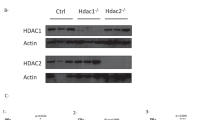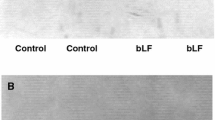Abstract
Intestinal epithelial cell differentiation is closely regulated during normal cell renewal, maturation, and malignant transformation. Since tyrosine phosphorylation influences differentiation in other cell types and has been reported to vary between crypt cells to differentiated villus tip cells, we investigated the influence of tyrosine phosphorylation in colonocyte differentiation, by using human colonic Caco-2 cells as a model and expression of the brush border enzymes alkaline phosphatase (AKP) and dipeptidyl peptidase (DPDD) as differentiation markers. We studied three tyrosine kinase inhibitors with different modes of action and specificities, viz., genistein, erbstatin analog (EA), and tyrphostin, and the tyrosine phosphatase inhibitor sodium orthovanadate. AKP- and DPDD-specific activities were assayed in protein-matched cell lysates by synthetic substrate digestion. We also correlated the effects of these agents on brush border enzyme activity with tyrosine phosphorylation of phosphoproteins by Western blotting. Genistein (5–75 mg/ml) dose-dependently stimulated AKP and DPDD with a maximal stimulation at 75 mg/ml by 158.6± 17.5% and 228.6±37.1% of control values, respectively (n=12, P<0.001). The inactive analog genistin had no effect. Tyrphostin (25 mM) similarly stimulated AKP and DPDD by 138.6±6.6% and 131.8±1.5% of control values (n=12, P<0.001). Unexpectedly, EA (0.1–10 mM) had the opposite effect, inhibiting AKP- and DPDD-specific activity significantly at 10 mM with a maximal 14.8±6.4% and 26.5±2.5% of control values (n=12, each P<0.001). Sodium orthovanadate had a discordant effect on these two differentiation markers. Orthovanadate dose-dependently increased AKP to a maximal 188.5±16.1% of basal activity at 1.5 mM but decreased DPDD activity at 1.5 mM to 47.2±3.8% (n=9, P<0.001 each). The effects of each agent were preserved when proliferation was blocked with mitomycin C, suggesting that the modulation of phenotype by these agents was independent of any effects of proliferation. The tyrosine phosphorylation of several phosphoprotein bands was affected differently by these agents. In particular, the tyrosine phosphorylation of one 70-kDa to 71-kDa band was increased by genistein and tyrophostin but deceased by EA. The different effects of these modulators of tyrosine kinase activity raise the possibility that at least two independent enzymes or pathways regulating tyrosine phosphorylation modulate intestinal epithelial differentiation. Furthermore, tyrosine phosphorylation of the 70-kDa to 71-kDa phosphoprotein may be important in the intracellular signaling by which intestinal epithelial cell differentiation is controlled.
Similar content being viewed by others
Author information
Authors and Affiliations
Additional information
Received: 23 September 1997 / Accepted: 17 December 1997
Rights and permissions
About this article
Cite this article
Basson, M., Emenaker, N. & Rashid, Z. Effects of modulation of tyrosine phosphorylation on brush border enzyme activity in human Caco-2 intestinal epithelial cells. Cell Tissue Res 292, 553–562 (1998). https://doi.org/10.1007/s004410051084
Issue Date:
DOI: https://doi.org/10.1007/s004410051084




